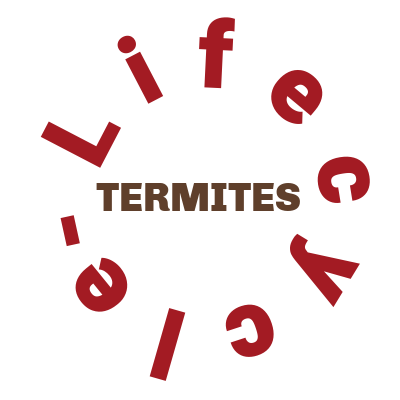The Lifecycle of a Termite Colony
 A termite colony begins with a swarm—typically 20 to 100 flying termites called alates, the winged reproductives that include future kings and queens. These termites leave their original colony to start a new one. Subterranean termites usually swarm in spring, typically the day after rainfall. Drywood termites, on the other hand, swarm in the fall on hot days. Despite their wings, neither species is a strong flier, and both are instinctively drawn to light.
A termite colony begins with a swarm—typically 20 to 100 flying termites called alates, the winged reproductives that include future kings and queens. These termites leave their original colony to start a new one. Subterranean termites usually swarm in spring, typically the day after rainfall. Drywood termites, on the other hand, swarm in the fall on hot days. Despite their wings, neither species is a strong flier, and both are instinctively drawn to light.
Once they land, both types shed their wings. Each alate finds a mate. Drywood termites will seek out a crack in wood to nest, while subterranean termites look for moist soil. The new queen lays her first batch of eggs. These hatch into larvae, and through a process called trophallaxis—the transfer of fluids from mature termites—essential protozoa are passed on, enabling the young to digest wood.
As termites grow, they go through a series of molts, shedding their exoskeletons and replacing them with larger ones. Each molt is known as an instar, and it typically takes six instars for a juvenile termite to reach maturity.
In drywood termite colonies, nymphs perform all the worker duties—chewing wood, feeding and grooming the queen and soldiers. In subterranean colonies, there is a distinct worker caste that does the same and more: foraging for food, maintaining the nest, and constructing mud tubes for movement and protection.
The queen controls the colony’s growth, influencing how many nymphs or workers develop into soldiers or reproductives. Not all reproductives leave during a swarm. Some remain behind as secondary or tertiary queens, helping expand the colony from within.
Soldiers develop large heads and powerful mandibles used to defend the colony—mostly from ants. When under attack, they rush out to fight, and the workers seal the exit behind them. Soldiers do not retreat.
Workers and soldiers live for 1–2 years, but queens can live up to 30 years under ideal conditions. Most swarmers, however, die shortly after leaving their colony. Only a small percentage survive, but that’s enough to sustain a billion-dollar pest control industry.
After about three to four years, a percentage of workers or nymphs mature into new swarmers, repeating the cycle.
Why Homeowners Should Care
A swarm inside a home means a colony has likely been chewing on the structure for three to four years. If it happens in a hidden area like an attic or crawl space, it may go unnoticed—and can result in multiple new colonies forming nearby.
That’s the bad news.
The good news? Most swarmers die before establishing new colonies. Also, because termites can’t digest wood without help from adults, fumigation is effective. While fumigation gases don’t kill the eggs (because they can’t penetrate egg casings), the hatchlings won’t survive without mature termites to feed them.
Still, when it comes to termites, even the good news tends to be just the lesser of two evils.
